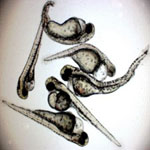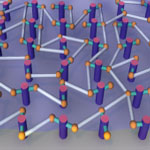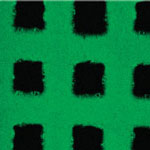Showing Spotlights 2209 - 2216 of 2780 in category All (newest first):
 Engineered nanoparticles are rapidly becoming a part of our daily life in the form of cosmetics, food packaging, drug delivery systems, therapeutics, biosensors, etc. A number of commercial products such as wound dressing, detergents or antimicrobial coatings are already in the market. Although little is known about their bio distribution and bio activity, especially silver nanoparticles are extensively used for all kinds of antimicrobial applications. Ultimately, these nanoparticles end up in the environment during waste disposal. Largely due to a scarcity of data on the toxicity, intracellular distribution and fate of silver ions and nanoparticles inside an organism, regulatory bodies so far have not felt the need to regulate the use of such materials in commercial products or disposal of such products. In order to improve the scientific data and to enhance our insight on the health and environmental impact of silver nanoparticles, scientists in Singapore have initiated an in vivo toxicology study to examine nanosilver in a zebrafish model. They conclude that silver nanoparticles have the potential to cause health and ecotoxicity issues in a concentration-dependent manner.
Engineered nanoparticles are rapidly becoming a part of our daily life in the form of cosmetics, food packaging, drug delivery systems, therapeutics, biosensors, etc. A number of commercial products such as wound dressing, detergents or antimicrobial coatings are already in the market. Although little is known about their bio distribution and bio activity, especially silver nanoparticles are extensively used for all kinds of antimicrobial applications. Ultimately, these nanoparticles end up in the environment during waste disposal. Largely due to a scarcity of data on the toxicity, intracellular distribution and fate of silver ions and nanoparticles inside an organism, regulatory bodies so far have not felt the need to regulate the use of such materials in commercial products or disposal of such products. In order to improve the scientific data and to enhance our insight on the health and environmental impact of silver nanoparticles, scientists in Singapore have initiated an in vivo toxicology study to examine nanosilver in a zebrafish model. They conclude that silver nanoparticles have the potential to cause health and ecotoxicity issues in a concentration-dependent manner.
Jun 6th, 2008
 Usually, when your read official government publications about the military's nanotechnology research and development activities, it's all about sensors, batteries, wound care, filtration systems, smart fabrics, and lighter, stronger, heat-resistant nanocomposite materials etc. It's all quite useful stuff for non-military applications as well, and - as described by these sources - it's all just for defensive purposes. A good example is the official and public annual report by the U.S. Department of Defense "Defence Nanotechnology Research and Development Program". Official sources keep quite mum though about military research into offensive nanotechnology applications. For instance, in the above-mentioned DoD report the words "explosive", "ammunition" or "bomb" don't appear even once. Does that mean the military is not researching nanotechnology applications for more effective ways of blowing stuff up, or are they just being tight-lipped about it? Your guess...
Usually, when your read official government publications about the military's nanotechnology research and development activities, it's all about sensors, batteries, wound care, filtration systems, smart fabrics, and lighter, stronger, heat-resistant nanocomposite materials etc. It's all quite useful stuff for non-military applications as well, and - as described by these sources - it's all just for defensive purposes. A good example is the official and public annual report by the U.S. Department of Defense "Defence Nanotechnology Research and Development Program". Official sources keep quite mum though about military research into offensive nanotechnology applications. For instance, in the above-mentioned DoD report the words "explosive", "ammunition" or "bomb" don't appear even once. Does that mean the military is not researching nanotechnology applications for more effective ways of blowing stuff up, or are they just being tight-lipped about it? Your guess...
Jun 5th, 2008
 The concept of a 'machine' - a mechanical or electrical device that transmits or modifies energy to perform a certain task - can be extended to the nano world as well. On the nanoscale, the nanomachine components would be molecular structures each designed to perform a specific task which, all taken together, would result in a complex function. Nanoscientists have already built molecular motors, wheels, and gears for powering nanomachines. The ability to control nanoscale motors, more specifically, to control the motion of molecular components of such motors, doesn't only involve acceleration and movement but, equally important, deceleration and stopping. So far, the development of a practical braking system for nanomotors remains a challenge. Researchers in Taiwan now have reported development of a light-driven molecular brake that could provide on-demand stopping power for futuristic nanotechnology machines.
The concept of a 'machine' - a mechanical or electrical device that transmits or modifies energy to perform a certain task - can be extended to the nano world as well. On the nanoscale, the nanomachine components would be molecular structures each designed to perform a specific task which, all taken together, would result in a complex function. Nanoscientists have already built molecular motors, wheels, and gears for powering nanomachines. The ability to control nanoscale motors, more specifically, to control the motion of molecular components of such motors, doesn't only involve acceleration and movement but, equally important, deceleration and stopping. So far, the development of a practical braking system for nanomotors remains a challenge. Researchers in Taiwan now have reported development of a light-driven molecular brake that could provide on-demand stopping power for futuristic nanotechnology machines.
Jun 4th, 2008
 Since its discovery in 2004, graphene has created quite a buzz among scientists. The reason they are so excited is that two-dimensional crystals (it's called 2D because it extends in only two dimensions - length and width; as the material is only one atom thick, the third dimension, height, is considered to be zero) open up a whole new class of materials with novel electronic, optical and mechanical properties. For instance, the ultimate size limit for a nano-electromechanical system would be a nanoscale resonator that is only one atom thick, but this puts severe constraints on the material; as a single layer of atoms, it should be robust, stiff, and stable. Graphene, the simplest of the 2D conjugated carbon nanomaterials, could fit that bill. One hurdle for researchers is that current methods for the synthesis of two-dimensional, carbon-rich networks have many limitations including lack of molecular-level control and poor diversity. In a step to overcome these obstacles, researchers have now developed new synthetic strategies for forming monolayer films of conjugated carbon, in various configurations ranging from flat 2D sheets, to balloons, tubes and pleated sheets.
Since its discovery in 2004, graphene has created quite a buzz among scientists. The reason they are so excited is that two-dimensional crystals (it's called 2D because it extends in only two dimensions - length and width; as the material is only one atom thick, the third dimension, height, is considered to be zero) open up a whole new class of materials with novel electronic, optical and mechanical properties. For instance, the ultimate size limit for a nano-electromechanical system would be a nanoscale resonator that is only one atom thick, but this puts severe constraints on the material; as a single layer of atoms, it should be robust, stiff, and stable. Graphene, the simplest of the 2D conjugated carbon nanomaterials, could fit that bill. One hurdle for researchers is that current methods for the synthesis of two-dimensional, carbon-rich networks have many limitations including lack of molecular-level control and poor diversity. In a step to overcome these obstacles, researchers have now developed new synthetic strategies for forming monolayer films of conjugated carbon, in various configurations ranging from flat 2D sheets, to balloons, tubes and pleated sheets.
Jun 3rd, 2008
 The controlled patterning of surfaces with biomolecules is of great importance for future generations of micro and nano biodevices (e.g. biochips, BioMEMS, lab-on-a-chip) and biomaterials. Even with current state-of-the-art technology, this patterning requirement, i.e. the immobilization and controlled and precise placement of biomolecules, often is a limiting step in the fabrication process. Commonly applied substrate materials for such biodevice applications are inexpensive polymers; but polymer surfaces are complex to chemically pattern in larger numbers. By combining two known techniques, micro-contact printing and injection molding in a new, innovative way, researchers in Denmark have now demonstrated a surprisingly successful methodology for transferring micro- and nanoscopic patterns of functionally active proteins to polymer surfaces during injection molding of hot polymer melt.
The controlled patterning of surfaces with biomolecules is of great importance for future generations of micro and nano biodevices (e.g. biochips, BioMEMS, lab-on-a-chip) and biomaterials. Even with current state-of-the-art technology, this patterning requirement, i.e. the immobilization and controlled and precise placement of biomolecules, often is a limiting step in the fabrication process. Commonly applied substrate materials for such biodevice applications are inexpensive polymers; but polymer surfaces are complex to chemically pattern in larger numbers. By combining two known techniques, micro-contact printing and injection molding in a new, innovative way, researchers in Denmark have now demonstrated a surprisingly successful methodology for transferring micro- and nanoscopic patterns of functionally active proteins to polymer surfaces during injection molding of hot polymer melt.
Jun 2nd, 2008
 Advanced material engineering techniques can structure surfaces that allow dynamic tuning of their wettability all the way from superhydrophobic (i.e. repelling) behavior to almost complete wetting (i.e. superhydrophilic or strongly absorbing) - but these surfaces only work with high-surface-tension liquids. Almost all organic liquids that are ubiquitous in human environment such as oils, solvents, detergents, etc. have fairly low surface tensions and thus readily wet even superhydrophobic surfaces. In a previous Spotlight we reported how researchers have been creating surfaces that would extend superhydrophobic behavior to all liquids, no matter what the surface tension. New work coming out of MIT now describes a novel nanostructures membrane that can be switched between superhydrophilic and superhydrophobic behavior on demand. Think of it as an 'oil spill clean-up paper towel' that absorbs only the oil but not the water. Given the global scale of severe water pollution arising from oil spills and industrial organic pollutants, this nanomaterial may prove particularly useful in the design of recyclable absorbents with significant environmental impact.
Advanced material engineering techniques can structure surfaces that allow dynamic tuning of their wettability all the way from superhydrophobic (i.e. repelling) behavior to almost complete wetting (i.e. superhydrophilic or strongly absorbing) - but these surfaces only work with high-surface-tension liquids. Almost all organic liquids that are ubiquitous in human environment such as oils, solvents, detergents, etc. have fairly low surface tensions and thus readily wet even superhydrophobic surfaces. In a previous Spotlight we reported how researchers have been creating surfaces that would extend superhydrophobic behavior to all liquids, no matter what the surface tension. New work coming out of MIT now describes a novel nanostructures membrane that can be switched between superhydrophilic and superhydrophobic behavior on demand. Think of it as an 'oil spill clean-up paper towel' that absorbs only the oil but not the water. Given the global scale of severe water pollution arising from oil spills and industrial organic pollutants, this nanomaterial may prove particularly useful in the design of recyclable absorbents with significant environmental impact.
May 30th, 2008
 Germany, with an almost 40% share of European public funded nanoscience research, is the clear nanotechnology leader in Europe. It is also one of the leaders globally in pushing research into potential risk and safety concerns associated with nanotechnology. The Federal Ministry of Education and Research (BMBF) is the ministry responsible for federal activities in the nanotechnology sector in Germany. Within its framework of 'leading-edge innovations' the BMBF supports key areas of nanotechnologies with promising prospects (NanoMobil, NanoChem, NanoFab, NanoforLife,NanoLux). The project NanoChance aims to support small and medium-sized companies in particular. The cooperative project NanoCare currently mainly focuses on studying possible risks of engineered nanoparticles. Beyond that, the federal agencies BAuA (Federal Institute for Occupational Safety and Health), UBA (Federal Environment Agency) and BfR (Federal Institute for Risk Assessment) have developed a joint research strategy that addresses especially health and environmental risks of engineered nanoparticles. The strategy has been finalized in December 2007 and a final report has just been published.
Germany, with an almost 40% share of European public funded nanoscience research, is the clear nanotechnology leader in Europe. It is also one of the leaders globally in pushing research into potential risk and safety concerns associated with nanotechnology. The Federal Ministry of Education and Research (BMBF) is the ministry responsible for federal activities in the nanotechnology sector in Germany. Within its framework of 'leading-edge innovations' the BMBF supports key areas of nanotechnologies with promising prospects (NanoMobil, NanoChem, NanoFab, NanoforLife,NanoLux). The project NanoChance aims to support small and medium-sized companies in particular. The cooperative project NanoCare currently mainly focuses on studying possible risks of engineered nanoparticles. Beyond that, the federal agencies BAuA (Federal Institute for Occupational Safety and Health), UBA (Federal Environment Agency) and BfR (Federal Institute for Risk Assessment) have developed a joint research strategy that addresses especially health and environmental risks of engineered nanoparticles. The strategy has been finalized in December 2007 and a final report has just been published.
May 29th, 2008
 Oscar Pistorius - also known as 'Blade Runner' - is a double leg amputee who is using specially developed artificial legs to compete in races. A world record holder in the 100, 200 and 400 meters Paralympic events, Pistorius was denied by the International Association of Athletics Federations (IAAF) his application to participate in the 2008 Summer Olympics. The IAAF argued that his prosthetic racing legs give him a clear competitive advantage. On May 16, the IAAF's decision was overturned by the Court of Arbitration for Sport, allowing Pistorius to participate in the Olympics if he could make the minimum qualifying time. This episode drives home the monumental issues our society will be facing in the not too distant future thanks to our increasing technological ability to enhance the human body. Terms like 'health', 'disease', 'therapy' and 'medicine' will have to be radically redefined.
Oscar Pistorius - also known as 'Blade Runner' - is a double leg amputee who is using specially developed artificial legs to compete in races. A world record holder in the 100, 200 and 400 meters Paralympic events, Pistorius was denied by the International Association of Athletics Federations (IAAF) his application to participate in the 2008 Summer Olympics. The IAAF argued that his prosthetic racing legs give him a clear competitive advantage. On May 16, the IAAF's decision was overturned by the Court of Arbitration for Sport, allowing Pistorius to participate in the Olympics if he could make the minimum qualifying time. This episode drives home the monumental issues our society will be facing in the not too distant future thanks to our increasing technological ability to enhance the human body. Terms like 'health', 'disease', 'therapy' and 'medicine' will have to be radically redefined.
May 28th, 2008
 Engineered nanoparticles are rapidly becoming a part of our daily life in the form of cosmetics, food packaging, drug delivery systems, therapeutics, biosensors, etc. A number of commercial products such as wound dressing, detergents or antimicrobial coatings are already in the market. Although little is known about their bio distribution and bio activity, especially silver nanoparticles are extensively used for all kinds of antimicrobial applications. Ultimately, these nanoparticles end up in the environment during waste disposal. Largely due to a scarcity of data on the toxicity, intracellular distribution and fate of silver ions and nanoparticles inside an organism, regulatory bodies so far have not felt the need to regulate the use of such materials in commercial products or disposal of such products. In order to improve the scientific data and to enhance our insight on the health and environmental impact of silver nanoparticles, scientists in Singapore have initiated an in vivo toxicology study to examine nanosilver in a zebrafish model. They conclude that silver nanoparticles have the potential to cause health and ecotoxicity issues in a concentration-dependent manner.
Engineered nanoparticles are rapidly becoming a part of our daily life in the form of cosmetics, food packaging, drug delivery systems, therapeutics, biosensors, etc. A number of commercial products such as wound dressing, detergents or antimicrobial coatings are already in the market. Although little is known about their bio distribution and bio activity, especially silver nanoparticles are extensively used for all kinds of antimicrobial applications. Ultimately, these nanoparticles end up in the environment during waste disposal. Largely due to a scarcity of data on the toxicity, intracellular distribution and fate of silver ions and nanoparticles inside an organism, regulatory bodies so far have not felt the need to regulate the use of such materials in commercial products or disposal of such products. In order to improve the scientific data and to enhance our insight on the health and environmental impact of silver nanoparticles, scientists in Singapore have initiated an in vivo toxicology study to examine nanosilver in a zebrafish model. They conclude that silver nanoparticles have the potential to cause health and ecotoxicity issues in a concentration-dependent manner.
 Subscribe to our Nanotechnology Spotlight feed
Subscribe to our Nanotechnology Spotlight feed





